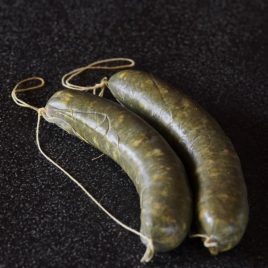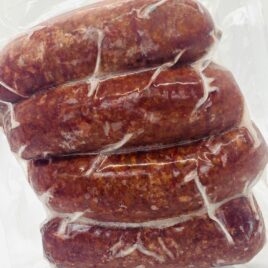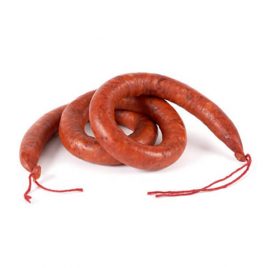Semi cured
Showing all 5 results

Catalan Pork Sausage
Butifarra is a product of Catalan origin, it is a pork sausauge that is seasoned with spices of which there mainly two types, the fresh butifarra and the dried sausage. The Catalan butifarra’s origin begins in the 14th century and its name is derived from the Latin root of Botillo Berciano or Galician butiello.
Over time a great variety of butifarra has emerged not only from Catalonia, this delicious sausage has spread through the Balearic Islands, Aragon, Valencia and as far as the Murcia region.
Unlike other sausages it contains no fat only lean meat from the tip of the loin and sometimes other cuts of lean pork. At most, a bit of chopped bacon is added as a condiment, but it never reaches large proportions (for example, half) as in other sausages from other countries. Sometimes the minced meat can be cooked lightly in the oven or can be seasoned with, for example, chopped mushrooms before being stuffed.
The sausage mixture is kneaded manually and then stuffed into thick pork casings 32-36mm. Then, the intestine is marked at each span with thick cotton thread and separated into different sausages, uncut, rolling each one with the casing.
The sausage is served with mongetes (white beans) it is the traditional most popular way of consuming this product, typically also in a bocadillo (bread roll) with manchego cheese or grilled with mustard or aioli. But beyond these preparations, the Catalan culinary culture has always claimed the prominence of the butifarra in a diverse and abundant cookbook.
Butifarra with its delicate aniseed and peppery flavours this sausage will harmonize with fleshy, light, dry to medium red wines.
Download our info sheet

Hot / Mild Chorizo
The sausage has been around since ancient Greek and Roman times and in the 12th Century in the Romanesque Calendar of San Isidoro the month of November is called the month of the slaughter of the pigs with the pork being used for the making of chorizo and other cured and dried sausage such as the Chorizo parrillero. There are references in a famous ancient Greek comediographer, Artisphones’ literary works where the main character appeared with a pot full of sausages and with a figure of a man holding a pig for sausage making.
The chorizo acquired its characteristic red colour during the 16th Century when the paprika arrived from South America and was introduced into Spanish cuisine. In Spain, a chorizo must have garlic and paprika to be considered authentic since this is what differentiates Spanish chorizo from other sausages. It is cured outdoors or smoked, and its main base is minced pork marinated with paprika giving it its typical red colour and unmistakable full flavour.
Our chorizo is made not only from four types of pimentón with a mix of Spanish family secret herbs, it is also made from three different parts of the Linley Valley Pork – the jowl, cheek and shoulder. The pigs raised in Western Australia at Linley Valley Pork are fed on a nutritious diet of Australian grains, such as barley, wheat and lupins. This ensures a high-quality base from which The Iberians Chorizo is produced.
It has a diameter of 30-40 millimetres and string form, with a compact and firm consistency, rugged sexy appearance, smooth cut, red colour with an intense balanced aroma with a pleasant texture to the palate, and full lasting flavour, very balanced between fat and lean and includes the spicy variety.
In different regions of Spain the chorizo is cooked using a variety of methods – for instance in Galicia they serve the chorizo flamed in aguardiente (a fermented alcoholic herb liquor), in Asturias it is cooked a la sidra (with cider) or simply pan-fried in olive oil or on the BBQ.
Download our info sheet

Green Chorizo
The Iberians have been on the trail of interesting and new smallgoods and we are loving the results. Inspired by the Los Angeles street taco scene Dez has been on the hunt for the secrets behind green chorizo’s, and it looks like he has found them. We have sourced a producer with the knowhow to create the vibrant Mexican green chorizo (Chorizo Verde). The specialty sausage originates from the area of Toluca, Mexico and is made from a combination of green chilli peppers, coriander, spinach, seeds and garlic to give the chorizo a very natural flavour that seasons the pork thoroughly with a spicy kick, but doesn't overpower the meat, creating a link with great flavour and balance.
This is a fresh take on the more traditional Spanish red chorizo and provides endless possibilities for your menu. Green chorizo is traditionally removed from its casing and used as a filling in tacos, but it has been reimagined by hundreds of chefs across the USA in its sausage form. It has been included as an element in seafood dishes and often as a breakfast item served with eggs. However, you decide it could be used on your menu, we know it will be a new addition to the Sydney and Melbourne dining scene.
Download our info sheet

Morcilla (Spanish black rice pudding)
Morcilla (black pudding), a Spanish tradition that makes a fine tapa. Increasingly present in the modern kitchen for its exquisite taste and its versatility: in puff pastry, pies, scrambled, grilled or pan fried ... Always delicious!
There are two types Malagueña and Burgos the first being made with onion and the second with rice.
With the Malagueña (Southern) made with caramelized onion. Only the very large variety was selected, with its strong robust flavour and firm protective skin. Planted in the spring and pampered in the family garden, it was harvested in autumn with great yields, hanging in aerated branches in a dry place for its conservation.
The Burgos (Northern) supporting ingredient rice which is added lightly cooked at low temperature which infuses the spices into the grain. This morcilla can be eaten "raw" (since it is already cooked), or fried, roasted, or smoked.
It combines very well in rolls, pintxos or slow cooked with legumes (beans, lentils or chickpeas), making a stew not only a gastronomic delight but also a dish with great nutritional value.
Download our info sheet

Txistorra (Pork belly chorizo)
To speak of the origin of the chistorra (txistorra) is to speak of the Navarre region in Spain. This rich sausage has a characteristic reddish colour and smoky paprika flavor and is made from a mixture of craft skills and history. The txistorra popular in a main meal or as an appetizer or snack.
It has been a tradition since ancient times pig farming has allowed many families and cities in Spain and its autonomous regions to obtain quality proteins and this is where the origin of chistorra comes from.
The txistorra or chistorra comes from the Basque term longaniza. It is a sausage of Basque-Navarrese and Aragonese origin. It is made with fresh minced pork meat, garlic, salt, aromatic herbs such as parsley and a good amount of paprika this gives it it’s characteristic colour and flavour.
Traditionally in Spain and as with today’s gourmet products every part of the butchered animal is used. In Guipúzcoa, due to climatic and or economic reasons, the pork slaughter was carried out shortly before the arrival of winter. In some localities like Lodosa in the Basque country the txistorra is usually made with the meat and lung of the pig.
In the Aragones and Navarra region of the Pyrenees the txistorra is made only with the pork meat. In Jaca’s Fields they have another variety made from the liver, and other remains of the pig, which is called arbiello, a word in Aragonese that means esophagus, since it is where the ingredients are stuffed.
In the province of León, the Chistorra de León is prepared, and is made with greater quantities of beef. Nowadays it is usually sold fresh, but increasingly you can buy it vacuum packed in a spiral shape in any of the Spanish supermarkets.
The txistorra has a characteristic flavour is very tasty and high in fat. It is usually eaten fried or roasted and is usually served as a midday dish in Madrid with "broken eggs and potatoes".
Tasting themes: Fried with apple cider and served with quality crusty bread, grilled whole in its spiral shape, in pinchos or with t fried broken eggs on top of roasted potatoes.
Download our info sheet

